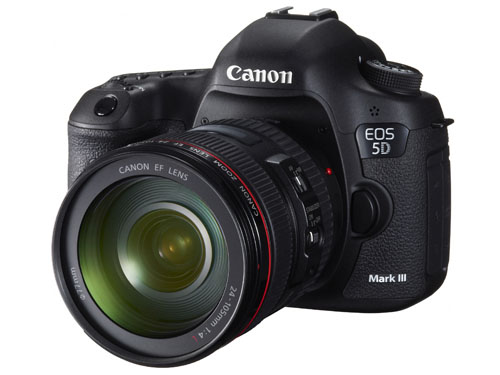Canon just release the new popular DLSR “5D Mark III“, with independent tests suggesting the core performance of its new 22-megapixel sensor is little improved from the 5D Mark II it replaces. Hot on the heels of Canon’s embarrassing confirmation that the hardware design of the EOS 5D Mark III has a flaw that allows light into the body, testing by specialists DxO Labs indicate only minor advantages from the new model and – unlikely to help in the ongoing Canon vs. Nikon platform war – performance still lagging behind that of the D800.

DxO Labs’ DxOMark testing looks at three distinct abilities of a camera: color depth (“portrait”), dynamic range (“landscape”), and low-light ISO (“sports”). Those three factors are then combined into an overall score for easier comparison between models.
DxO gave the 5D Mark III sensor a score of 81 on the DxOMark test of image sensor performance when shooting raw photos. That’s an all-time Canon best, but it’s only a bit ahead of the 5D Mark II’s score of 79 and well behind that of the camera’s top competition, Nikon’s D800, whose score of 95 tops the DxOMark list.

The D800 outpaced the 5D Mark III in all three of DxOMark’s areas: color depth, dynamic range, and low-light performance. In particular, the 36-megapixel D800 is head and shoulders above the 5D Mark II in dynamic range at lower ISO, meaning it does a better job capturing both darker shadows and brighter highlights.
Canon’s camera edged out the D800 at high-ISO settings, though, and is a close match for image noise. Check below for some comparisons.
Not everybody shoots raw, and videographers in particular don’t even have the option, so DxO’s tests don’t paint a full picture. When it comes to the on-camera noise reduction used for JPEG and H.264 video, Canon asserts that the 5D Mark III outdoes the Mark II by about two stops, meaning that shutter speeds can be quartered, ISOs can be quadrupled, or depth of field can be deepened without loss of image quality. The 5D Mark III can shoot video as high as ISO 6,400 compared to 3,200 for the 5D Mark II.
And the DxOMark test only measures the sensor’s performance. The overall camera quality also includes many other factors such as autofocus, durability, burst shooting speed, lens selection, video performance, accessories, user interface, and of course price. The Canon model costs $3,500 compared to $3,000 for the Nikon.
Both models are full-frame cameras, meaning that the image sensor is the size of a 36x24mm frame of 35mm film. In comparison, most SLRs use smaller and cheaper “APS-C” sensors that generally don’t afford as much image quality.




Buy 5D Mark III or Nikon D800 from Amazon.com